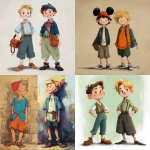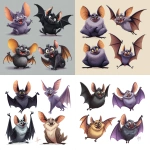Explore the Best AI Image Gallery

The Digital Canvas: Wearable Tech as a New Frontier for Artistic Expression
The realm of creativity has always been defined by innovation, constantly pushing boundaries and exploring novel mediums. Today, wearable technology stands at the forefront of this evolution, redefining how we create, interact with art, and express ourselves.
From augmented reality (AR) glasses that overlay digital elements onto our physical world to haptic suits that translate sound into tactile sensations, wearable tech offers a plethora of tools for artists and designers to experiment with. These technologies blur the lines between the physical and digital, opening up exciting possibilities for immersive and interactive experiences.
Applications Across Artistic Disciplines
The impact of wearable tech transcends traditional art forms, permeating various disciplines:
- Visual Arts: AR glasses allow artists to project their creations onto real-world surfaces, transforming mundane environments into dynamic artworks. Haptic gloves can translate brushstrokes into vibrations, enabling a more tangible connection between artist and creation.
- Music: Wearable sensors can capture body movements and translate them into musical notes, creating interactive performances where the audience becomes part of the composition. Sound-reactive clothing that changes color or texture based on music adds a visually captivating element to live shows.
- Dance: Choreographers can utilize wearable tech to track dancers movements in real-time, generating visuals or soundscapes that respond to their performance. This fosters a collaborative and dynamic interplay between the dancer and technology.
Ethical Considerations
As with any transformative technology, ethical considerations are paramount when integrating wearable tech into the creative process:
- Data Privacy: Wearable devices collect vast amounts of personal data, raising concerns about user privacy and potential misuse. It is crucial to implement robust security measures and ensure transparent data handling practices.
- Accessibility: Cost and accessibility can be barriers to entry for some creators. Efforts should be made to develop affordable and inclusive wearable tech solutions that empower a diverse range of artists.
- Authenticity and Originality: The increasing reliance on technology raises questions about the nature of artistic authorship. It is essential to establish clear guidelines and ethical frameworks regarding the use of AI-generated content in creative works.
Future Trends
The evolution of wearable tech continues at a rapid pace, with exciting advancements shaping the future of creativity:
- Brain-Computer Interfaces (BCIs): Imagine translating your thoughts directly into art or music. BCIs have the potential to revolutionize creative expression by bridging the gap between mind and machine.
- Immersive Experiences: Wearable tech will continue to enhance immersive experiences, creating captivating virtual and augmented reality environments where artists can showcase their work in entirely new ways.
- Personalized Creativity: Wearable sensors and AI algorithms can analyze individual creative preferences and generate personalized art suggestions or tools, empowering users to explore their unique artistic potential.
The convergence of wearable tech and creativity is poised to redefine artistic expression, fostering a future where technology empowers artists to push boundaries, ignite imaginations, and connect with audiences in unprecedented ways. As we navigate this evolving landscape, it is crucial to embrace ethical considerations, promote inclusivity, and foster a collaborative environment that celebrates the boundless potential of human creativity amplified by technological innovation.















](https://images.ai-img.art/thumbnails/150/8d1fe5a7a49cfc96747182431a853357913286d89258383caab2d3b4681afcb5.webp)

](https://images.ai-img.art/thumbnails/150/269414b0e541026702e9e67c67602c96162f37ff460a388b3b36314c8fc936dd.webp)







](https://images.ai-img.art/thumbnails/150/5197af8969d850e2a43e141d41e482ccbceedebceb2a4caf9f098f943f9d1b0f.webp)










](https://images.ai-img.art/thumbnails/150/3020b8c2b6d9be07e042357107af1de10deb274a41d2b0f332684ad4b532a702.webp)







](https://images.ai-img.art/thumbnails/150/485c8b1c747827bdc9a962f8a1919b3c259b18dd263b260208a1eae19fb85e07.webp)

](https://images.ai-img.art/thumbnails/150/2fbd98ecfc425cfc1597779121e1c0305437067779e9c471eb64ff9615d5be98.webp)


